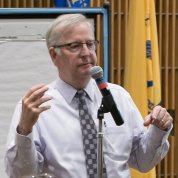Atherosclerosis as a Model for Studying Combined Exposures

Photo: Michael Garske
In the first workshop of its kind, clinicians, psychologists and researchers gathered at NIEHS recently to explore approaches to studying combined health effects of exposures to both chemicals and nonchemical stressors. Organizers from NIEHS and NHLBI selected atherosclerosis as the model disease for the workshop because both types of exposures are known to play a role in its development.
“We know that lifestyle, nutrition, age and gender all affect atherosclerosis, but [how about] other things, such as psychosocial stress, lack of sleep or the chemicals we’re exposed to on a daily basis?” asked Dr. Danielle Carlin, one of the lead organizers and a scientist in the NIEHS Hazardous Substance Branch. “There’s evidence that arsenic, lead and cadmium contribute,” she added. “Can we find specific mechanisms through which these factors interact with each other?”
Although the answers are far from clear, Carlin noted that inflammatory processes appear to be highly involved. She and two scientists from NHLBI, Dr. Michelle Olive and Dr. Catherine Stoney, led the organizing effort. They and others will prepare a paper on outcomes from the two days of presentations, discussions and brainstorming sessions for publication in a peer-reviewed journal.
Dr. David Goff, director of NHLBI’s Division of Cardiovascular Sciences, and Dr. Linda Birnbaum, director of NIEHS and the National Toxicology Program, welcomed attendees to the workshop. Birnbaum charged them with determining approaches to studying biological mechanisms and interactions of both types of stressors with respect to atherosclerosis. The disease is dangerous because it results in constricted blood vessels and the potential for plaque to rupture, leading to a clot that can block blood flow. Furthermore, scientists know that the body may respond more intensely to a combination of chemicals compared with a single chemical.
Stoney was pleased by the intense focus of meeting attendees. “It was a very collegial group,” she said. “They took their task very seriously, which gives a sense of how important the topic is.” Participants enjoyed the interdisciplinary nature of the discussions. Olive said the meeting drew a unique mix of scientists, including cardiologists, comparative medicine experts, toxicologists, psychologists, immunologists, epidemiologists, public health scientists, systems biology experts, imaging experts, geneticists and chemists.
Not surprisingly, the exposures and mechanisms discussed were similarly broad and complex. Presenters highlighted chemical stressors such as ozone, fine particulate matter, nutrient deficiencies and metals, as well as bisphenol A and polychlorinated biphenyls. Geospatial data on heart disease mortality highlighted increasing geographic disparities.
Nonchemical stressors ranged from poverty, psychosocial stress and the built environment to sleep and circadian rhythm disruptions, depression, anxiety, infection and sedentary lifestyles. “Cytokines, bone marrow and the sympathetic nervous system are involved,” said Stoney, highlighting inflammatory pathways addressed by many of the presenters. “When you’re under a lot of stress, it triggers the bones to produce more inflammatory cells, which make their way into blood vessels and cause plaque formation.”
On the chemical side, inhalation of particulate matter, for example, is linked to pulmonary oxidative stress and inflammation. Both eventually affect the heart. “There’s definitely room for more research,” said Olive. “For the paper, we’ll invite each participant to reference the literature that supports known mechanisms.”




